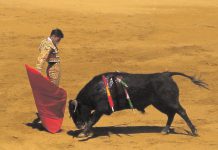
A trip to Cádiz, (or how far would I travel for a free meal?)
It’s quite easy to justify a trip to Cádiz; it is said to be the oldest continuously-inhabited city in south-western Europe, Columbus sailed from here and some call it the Havana of Europe. All this and only around 240 km by road from Malaga.
I have written before about my Spanish “to see” list and Cádiz was very near if not at the top. My wife and I mentioned this to some friends, and a plan was soon hatched for a long weekend there. We booked the 4-star Hotel Barceló via the web site Expedia for a very good value for money 154 € per couple for 2 nights. The hotel was a new boutique hotel just 15 minutes walk (allegedly) from the old part of town. I had never heard of the Barceló group before, but it transpires that it owns 185 four or five star hotels around the world, including some in the UK.
The quickest route to Cádiz would appear to be on the E15 Autovia along the coast past Tarifa, but we went via Antequera and Olvera (a very interesting looking town perched high on a hill that I would like to investigate further) and Arcos de la Frontera. This route was not only more interesting than the Autovia one, but had clear roads so we arrived in little over 3 hours. Once in Cádiz we drove around looking for our hotel, assuming it was on the coast (preparation is everything!) we finally dug out the address. It was actually one road back from the coast and turned out to be a huge white building with ‘Barceló’ written on the side of it in 8 foot high blue letters – note top self, book eye examination.
We checked in and quickly began exploring the city. Cádiz is effectively an island; built on a peninsula. There are two roads in; the CA-33 which runs with a rail track and the N-443 carried by the José León de Carranza Bridge. Cádiz is relatively small, just 12.1 km², making it very difficult to get lost in the winding streets of the old town as the sea is never far away on either side.
The beginning of the old town is marked by las Puertas de Tierra (the doors of earth)
which date from the 16th century but were modified in the 20th century to accommodate traffic. The walk had actually taken 22 minutes from the hotel, but we vowed to prove the publicity right by making it back to the hotel in 15. By now it was early evening so number one priority for me was to find somewhere to eat that night (culture schmulture!). Our search proved successful and after a 19 minute walk back to the hotel for a shower and to change, we headed back to the old town, this time clocking in 17 minute group personal best time. The restaurant, Sopranis on calle Sopranis offered good food at a reasonable price. Judging by the décor it must have been newly opened when we visited. The atmosphere was relaxed and the only thing that let it down should I be one to moan (ahem) was the slightly pretentious water menu, with their ‘Aguas del Mundo’ ranging from 5 to 10 € per bottle!
Following a good meal we tried to find a bar for a night-cap but were astonished to find everywhere closed, including the hotel bar at midnight. In all honesty we probably did not need anymore alcohol as we planned to meet at 9.30 the following morning to carry on our tour of the city.
When in tourist mode I would always advocate taking the tourist open-top bus tour should one be available. They allow you to get your bearings and you can choose which things of interest you would like to go and see in detail. The 24-hour ticket also means you can hop on and off as you like. The bus we used in Cádiz was operated by the City Sightseeing company, a global organisation operating in 70 cities. However, I would not recommend using this bus in Cádiz. Admittedly our timing was off and just after we paid our 12 € each the bus was invaded by tens of fellow tourists who had presumably just left the huge Italian ocean liner docked in the port. This meant the top deck was full so we were all crammed on the lower deck which was uncomfortably hot with no air conditioning. Also the head phones with which you are provided for the audio commentary were useless for some, as each pair of seats only had 1 earphone jack-plug. The tour only had 9 stops with little to see as we discovered most tourist sites are within the old town and not accessible by the bus. One interesting thing they did tell us was that a legend told of a treasure ship that crashed just off Cádiz causing the locals to search on the beach for the booty. Sure enough the next day we saw a man on the beach using a metal detector! My tip would be to ignore the bus in Cádiz and head straight for the Camera Obscura (camara oscura) on the Torre Tavira at calle Marqués del Real Tesoro 10. For those that do not know a camera obscura uses mirrors and lenses to project a huge panoramic view, allowing the operator to focus on objects both near and far.
Torre Tavira is the highest tower in Cádiz, and via the camera and the operator speaking in Spanish and English, gives you some very interesting information about the different styles of towers that you can see above the rooftops of the city. Said towers were built as look-out towers to scan the seas for invaders.
We also visited the cathedral which was built in the 18th century in the High Baroque style. There are in fact 3 aspects to visiting the cathedral; to go inside the cathedral and see the crypt costs 5 €. There is also a Phoenician burial site and Roman Temple next to the cathedral. These can be viewed in conjunction with Torre de Poniente, one of the cathedrals towers for another 5 €. The cathedral plaza is also an ideal place to get a drink or snack but be prepared to pay over the odds for the location.
So what of the free meal mentioned in the title? Our friends, Billy and Margo had visited Jerez de la Frontera the previous month and ate at a restaurant called Churchill’s, which is run by an English couple. After the meal they were asked to fill-in a feedback card that gets entered into a free monthly draw. Some weeks later they received a call saying they had won the draw entitling them to a meal to the value of 100 €. Being in the vicinity it seemed silly not to travel the 40 km to collect the meal. We decided to take the train allowing us all to have a few polite Sherries. After proving that the hotel to old town walk could not be done in 15 minutes, we caught the bus to the train station, purchased tickets from the automatic ticket machine and boarded the train. Once en route the ticket inspector approached us, checked our tickets and then appeared to say “cerca canillas”. We were impressed that he knew where we lived near to, but then realised were on the wrong train. Our ‘cercanías’ tickets we had purchased only allow travel locally on commuter trains. We were on the Andalucia Express. But far from being the jobs-worth type you normally encounter on British trains he waved our concerns away saying “tranquilo, tranquilo” proving that sometimes being ignorant, confused tourists does help.
The free meal turned out to be very good and the restaurant, although owned by Brits, was very multi-cultural as we were served by a Sicilian who spoke Spanish, English, Italian and Arabic.
To summarise, Cádiz has something for everybody; culture, history and it wide sandy beaches. We definitely plan to return, preferably in February to experience the Carnaval de Cádiz, one of the worlds best known carnivals which is said to be based on the Carnival of Venice. Locals and visitors alike don masks and costumes, with music playing a big part; with Flamenco and music groups filling the plazas and streets. The 2009 carnival is on from the 19th of February to the 1st of March. Be sure to book early as the carnival attracts thousands of visitors each year.






















